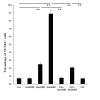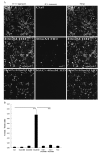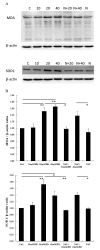2,5-hexanedione induced apoptosis of rat bone marrow mesenchymal stem cells by reactive oxygen species
- PMID: 27010086
- PMCID: PMC5356963
- DOI: 10.1539/joh.15-0143-OA
2,5-hexanedione induced apoptosis of rat bone marrow mesenchymal stem cells by reactive oxygen species
Abstract
Objectives: n-Hexane, a common industrial organic solvent, causes multiple organ damage, especially neurotoxicity, which is proved to be caused by its metabolite 2,5-hexanedione (2,5-HD). We previously showed that 2,5-HD induced apoptosis of rat bone marrow mesenchymal stem cells (BMSCs). In the current study, we explored the mechanism of 2,5-HD-induced apoptosis, especially the role played by reactive oxygen species (ROS).
Methods: Intracellular ROS levels after 2,5-HD treatment were measured by the dichloro-dihydro-fluorescein diacetate (DCFH-DA) method, and the antioxidant N-acetyl cysteine (NAC) was used to scavenge ROS. Apoptosis, mitochondrial membrane potential (MMP), and caspase-3 activity were measured after 2,5-HD exposure with or without NAC pretreatment.
Results: In rat BMSCs, 20 mM 2,5-HD significantly increased ROS levels and apoptosis. In addition, MMP activity was decreased and caspase-3 activity was increased. With NAC pretreatment, ROS increases were prevented, cells were rescued from apoptosis, and both MMP and caspase-3 activity returned to normal levels. Western blotting analysis of malondialdehyde-modified proteins and superoxide dismutase (SOD) 1 showed that after 2,5-HD exposure, BMSCs had oxidative damage and abnormal SOD1 expression. These returned to normal when cells were pretreated with NAC in addition to 20 mM 2,5-HD. Furthermore, the expressions of NF-κB p65/RelA and phospho-NF-κB p65/RelA (Ser536) were suppressed after 2,5-HD exposure and restored by NAC pretreatment.
Conclusions: 2,5-HD-induced apoptosis in rat BMSCs is potentially mediated by excessive ROS production.
Conflict of interest statement
Figures






Similar articles
-
2,5-hexanedione induced apoptosis in mesenchymal stem cells from rat bone marrow via mitochondria-dependent caspase-3 pathway.Ind Health. 2015;53(3):222-35. doi: 10.2486/indhealth.2014-0182. Epub 2015 Jan 29. Ind Health. 2015. PMID: 25739802 Free PMC article.
-
2,5-hexanedione induces bone marrow mesenchymal stem cell apoptosis via inhibition of Akt/Bad signal pathway.J Cell Biochem. 2018 Apr;119(4):3732-3743. doi: 10.1002/jcb.26602. Epub 2018 Jan 11. J Cell Biochem. 2018. PMID: 29236316
-
Erythropoietin (EPO) protects against high glucose-induced apoptosis in retinal ganglional cells.Cell Biochem Biophys. 2015 Mar;71(2):749-55. doi: 10.1007/s12013-014-0259-z. Cell Biochem Biophys. 2015. PMID: 25287674
-
[Clematichinenoside AR protects bone marrow mesenchymal stem cells from hypoxia-induced apoptosis by maintaining mitochondrial homeostasis].Zhongguo Zhong Yao Za Zhi. 2025 Mar;50(5):1331-1339. doi: 10.19540/j.cnki.cjcmm.20241014.704. Zhongguo Zhong Yao Za Zhi. 2025. PMID: 40350916 Chinese.
-
Taurine inhibits 2,5-hexanedione-induced oxidative stress and mitochondria-dependent apoptosis in PC12 cells.Ind Health. 2017 Apr 7;55(2):108-118. doi: 10.2486/indhealth.2016-0044. Epub 2016 Nov 11. Ind Health. 2017. PMID: 27840369 Free PMC article.
Cited by
-
Hypoxia induces senescence of bone marrow mesenchymal stem cells via altered gut microbiota.Nat Commun. 2018 May 22;9(1):2020. doi: 10.1038/s41467-018-04453-9. Nat Commun. 2018. PMID: 29789585 Free PMC article.
-
Proapoptotic effects of 2,5‑hexanedione on pheochromocytoma cells via oxidative injury.Mol Med Rep. 2019 Oct;20(4):3249-3255. doi: 10.3892/mmr.2019.10546. Epub 2019 Aug 1. Mol Med Rep. 2019. PMID: 31432125 Free PMC article.
References
-
- Huang CC. Polyneuropathy induced by n-hexane intoxication in Taiwan. Acta Neurol Taiwan 2008; 17: 3-10. - PubMed
-
- Neghab M, Soleimani E, Khamoushian K. Electrophysiological studies of shoemakers exposed to sub-TLV levels of n-hexane. J Occup Health 2012; 54: 376-382. - PubMed
-
- Kim MS, Park HR, Park M, et al. . Neurotoxic effect of 2,5-hexanedione on neural progenitor cells and hippocampal neurogenesis. Toxicology 2009; 260: 97-103. - PubMed
-
- LoPachin RM, DeCaprio AP. gamma-Diketone neuropathy: axon atrophy and the role of cytoskeletal protein adduction. Toxicol Appl Pharmacol 2004; 199: 20-34. - PubMed
MeSH terms
Substances
LinkOut - more resources
Full Text Sources
Other Literature Sources
Research Materials
Miscellaneous

